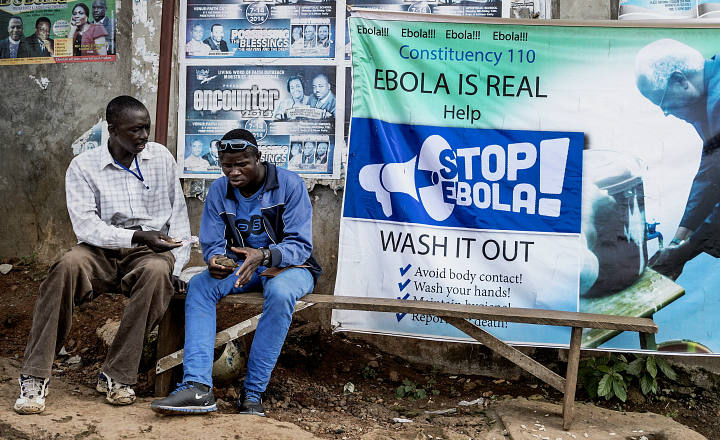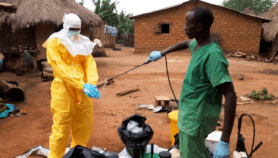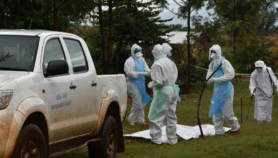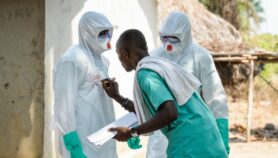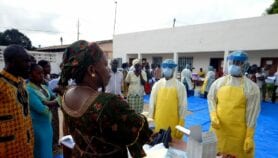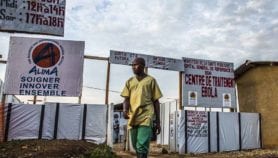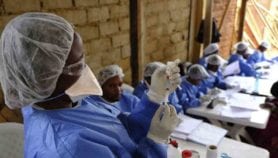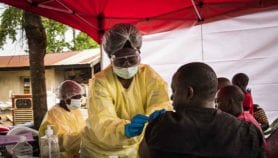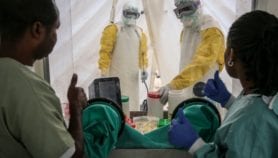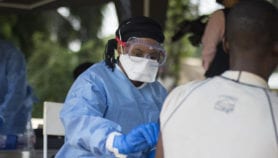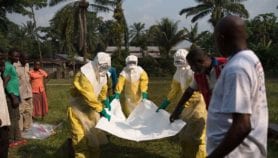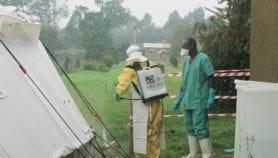By: Amzath Fassassi
Send to a friend
The details you provide on this page will not be used to send unsolicited email, and will not be sold to a 3rd party. See privacy policy.
Rumours about Ebola generated social challenges that were real but surmountable, finds Amzath Fassasi.
As the Ebola epidemic was advancing on Guinea’s capital Conakry in April 2014 a powerful rumour started to spread among the people living on the outskirts. Onions and coffee, so the saying went, could protect against the disease. Within hours, onions were completely sold out at the stalls of the city’s main market.
Of course, the rumour was false. “Given the place of onions in Guinean cuisine and the amount of onions consumed by each Guinean every day, if Ebola could be cured by onions, the virus would not even have crossed our borders,” says Sakoba Keita, the national coordinator of the Guinean health ministry’s response team.
Despite the health authorities’ immediate efforts to discredit the rumour on social media and through radio, it spread rapidly, becoming one of many examples of misinformation that made it difficult for response teams to help people stem Ebola’s spread.
False information took many forms during the epidemic. Some people did not believe in Ebola at all. Others believed it existed but had wrong ideas about how and why it was spreading.
Some proposed fanciful remedies, of which the onions-and-coffee-treatment is one of the less harmful examples.
“Even until now, part of the population still doesn’t believe in the existence of Ebola,” says Keita. “They believe it was invented by the authorities.”
Mandé Sylla, who runs a small business in central Conakry, experienced the misinformation first hand. At the height of what he calls the “psychosis” in Conakry, every day there were efforts to help people remember to wash their hands. But some local people saw the disease as a plague sent by God only on atheists, so they came to treat the exercise as a religious purification ritual rather than a hygiene measure, Sylla says.
Other strategies to combat the virus, such as spraying houses to disinfect them, were sometimes perceived as doing exactly the opposite. Keita says many people believed that the spray, which was laced with chlorine for disinfection, also contained the Ebola virus. They believed “that the spray was a propagation factor”, Keita says. Similar rumours soon spread about the thermometers used to measure body temperatures.
The health staff who took away the sick and gathered dead bodies had to work quickly, with little time to communicate what they were doing, or why. Often, their actions clashed with communities’ religious beliefs and traditions. Relatives were not allowed to touch the deceased and go through traditional funeral rites. This gave rise to conspiracy theories. Keita explains that many people began to strongly oppose the Guinean government’s strategy to manage corpses. “They thought we collected organs from the bodies for sale,” he says.
Once Ebola spread beyond the borders of Guinea, confusion about its causes and treatment worsened. In August 2014 a young Guinean was diagnosed with Ebola in Dakar, Senegal’s capital. Many Senegalese believed the disease was a punishment from God and so would only affect certain people. As a result, they brushed aside the hygiene measures recommended by health authorities.
Horror stories
At the height of the epidemic, when hundreds of people died every day, panic spread. In radio broadcasts and stories spread by word of mouth, Ebola was portrayed as an inescapable, apocalyptic threat.
Jérôme Mouton, head of the Médecins Sans Frontières response team in Guinea, says Ebola was used as a source of horror in literature and movies across West Africa, turning the disease into a “big scarecrow”.
“The first messages that were broadcast portrayed Ebola as a disease that kills almost every time and one that has no cure,” he says. “With such messages, to obtain a rational and thoughtful response from the population was obviously not easy. Instead of appeasing, rescue teams, in some situations, reinforced fear.”
Meanwhile, misinformation was also spreading over the internet. From the onset of the crisis, health authorities tried to use social networks such as Twitter and Facebook to distribute information on Ebola and gather hints on where their response teams might be needed next. But although social networks reach many people, it soon became clear they were not always an appropriate forum in which to discuss complex issues. Information about Ebola’s spread and prevention got muddled, warped and hyped. Social media users spread half-truths and rumours in an environment already gripped by a general panic, propagating misinformation quickly.
This was exacerbated by the lack of reliable conventional media channels to broadcast reliable information. In fact, in the rush for sensational news, some traditional media outlets repeated ridiculous rumours that Ebola was a ‘Zombie disease’ sent by God to punish atheists.
“After I got infected many people kept saying I had no chance of surviving because there was no cure for Ebola. I started to fear the worst.”
SaaSabasse Tèmèsadouno, Guéckédou hospital
Some news channels blatantly harnessed misconceptions to further their own goals, for example by playing on existing political and ethnic rivalries in the country, says Charles Vieira Sanches, the senior programme manager for West Africa’s branch of Article 19, an NGO working to defend freedom of speech. For instance, in Guinea the leader of the opposition party claimed that the ruling party were selectively spreading Ebola to the forested regions of the nation. Sanches and his team initiated a number of awareness campaigns on social networks, and tried to limit the political damage and social unrest this rumour and others like it were doing.
According to Sanches, the Ebola crisis flagged up the health services’ inability to maintain clear information channels when faced with an epidemic. The lack of trust between the general public and the region’s political and social elite only increased the problem.
Sanches thinks this explains why Ebola even broke out in communities that were already under the care of health workers.
Mystical explanations
The rumours about Ebola were creating unease even among well-educated people. One woman in Guinea told Sanches how, when an entire family in her neighbourhood died, she became incredibly unsettled. Under those circumstances, and in a culture where mystical explanations aren’t always taboo, “people began to believe in anything”, she said.
One of the things that people clung to was witchcraft. Supernatural forces are still a reality in the minds of many African societies, even those with advanced education and social development. In West Africa, many people responded to mystical explanations of the disease by seeking out traditional healing, despite government efforts to discourage such practices.
And sometimes, the witchcraft remedies would appear to work, potentially reinforcing such beliefs. Sylvain Faye, a social anthropologist working with the WHO in Guinea, reports a case where a patient tested positive for Ebola and went to see a traditional healer. He was later tested again, and that time declared Ebola-free.
Regardless of whether the test or the man’s initial symptoms were misinterpreted, Faye and his team feared that such incidents increased beliefs that the disease was being deliberately spread by international organisations.
“How this happened remains a mystery,” Faye says of the case. “We didn't want to give it any form of publicity, which could only reinforce beliefs that traditional practitioners were better equipped than conventional medical staff to deal with Ebola, which, in any case, is wrong.”
The idea that Ebola was a supernatural evil also meant that those who got infected often doubted their ability to recover. SaaSabasse Tèmèsadouno, a health worker at Guéckédou hospital in Guinea, was infected with Ebola whilst caring for other victims.
As a medical assistant, Tèmèsadouno had some basic knowledge about the virus. But he still doubted his own ability to recover due to persistent rumours that Ebola was caused by witchcraft.
“After I got infected many people kept saying I had no chance of surviving because there was no cure for Ebola,” he told SciDev.Net. “I started to fear the worst.” Fortunately, he did recover.
Transparency strategy
It took a long time for response teams and international health agencies to take misinformation on Ebola and its effect on local people seriously. Keita admits that the disease’s social effects were “initially put aside in our technical planning”. It was not until the height of the epidemic, around July 2014, that response teams realised how the social constraints generated by misinformation prevented them from stopping the epidemic. “We therefore had to take these parameters into consideration,” adds Keita.
To address rumours, health authorities called in social anthropologists for advice, and used information relays such as radio and newspapers, artists, and religious and community leaders.
One essential part of the strategy, according to MSF’s Jérôme Mouton, was to make treatment centres and what goes on inside them more transparent to the general population. From the start, health workers had experienced problems related to these centres. Since Ebola patients need to be strictly isolated and will, for a time, only come in contact with people in strange-looking protection coats, the experience of being taken away to a centre is traumatising both for patients and their relatives.
Mouton said that this “isolation aspect” of the disease fed the rumours. “When people do not know what's going on, they imagine all sorts of terrible things,” he says. “For instance, there were rumours that the centres were used for organ trafficking. No one, under such circumstances, would want to be treated in our centres.”
MSF decided to be clearer about how Ebola treatments work and to let healthy people look around into freshly opening health stations.
“Once people are convinced of the value for their communities to temporarily suspend certain traditions in the interest of public health, communication with the population becomes much easier.”
Jérôme Mouton, MSF
“When we inaugurated new centres, we’d ask the population to visit them and understand what they were all about,” Mouton explains.
Stressing the need for better communication, Keita adds that his response teams persuaded religious and community leaders to speak to the population “so they understand the ins and outs of the disease”. Anthropologists also helped Guinea’s health ministry to better understand people’s habits and so improve Ebola responses.
Surmountable challenge
For Mouton, the communication problems were not an insurmountable clash between tradition and modernity. He found that patiently and sensitively distributing accurate information about Ebola treatment and prevention did work — and it was more effective than trying to debunk witchcraft and traditional medicine.
“Once people are convinced of the value for their communities to temporarily suspend certain traditions in the interest of public health, communication with the population becomes much easier,” he says.
But Mouton notes that such information campaigns are complicated and time-consuming, especially in the midst of an all-out health crisis. “These are things that can only be addressed at the community level through talking directly to the population,” he says.
While MSF took communication down to the micro level, Sanches’ team continued to focus on relaying information and fighting Ebola stereotypes online. The Article 19 team had to battle distrust of health workers and international aid agencies among local people and the authorities.
“There was some distrust in organisations perceived as the invisible hands of the West,” Sanches says. Putting out reassuring messages on social media helped counter such ideas, but Sanches believes that it was only through a mix of information channels, including broadcasting and word of mouth, that opinions on Ebola were finally changed.
Article 19 used its #SenStopEbola (Senegal Stop Ebola) initiative to convince popular bloggers to focus their writing on the disease. They asked the writers to prioritise posts that addressed and cleared up rumours and misunderstandings. The organisation also worked with popular artists, including Ivory Coast reggae music star Tiken Jah Fakoly, to give its messages more clout.
A year on from the height of the outbreak, Ebola is abating and life in West Africa is slowly returning to normal. Nonetheless, the epidemic killed more than 10,000 people and has left families, villages and communities devastated.
It is difficult to know whether the disease might have progressed differently if misinformation had been addressed sooner. But it is clear to all those who experienced the outbreak that addressing fears and rumours head-on was crucial to getting on top of the virus.
“Fear is an important part of all problems we had to face while dealing with the Ebola epidemic,” says Mouton, adding that the panic caused by the epidemic explains why even the most outlandish Ebola rumours were so easily believed. “Fear has never helped people to think in a sensible manner. When we are scared, we no longer act rationally.”
Amzath Fassassi is the regional coordinator for SciDev.Net’s Sub-Saharan Africa French desk.
Julien Chongwang and Faran Maϊgari contributed additional reporting to this story.
This article is part of our Spotlight, Managing health crises after Ebola.


